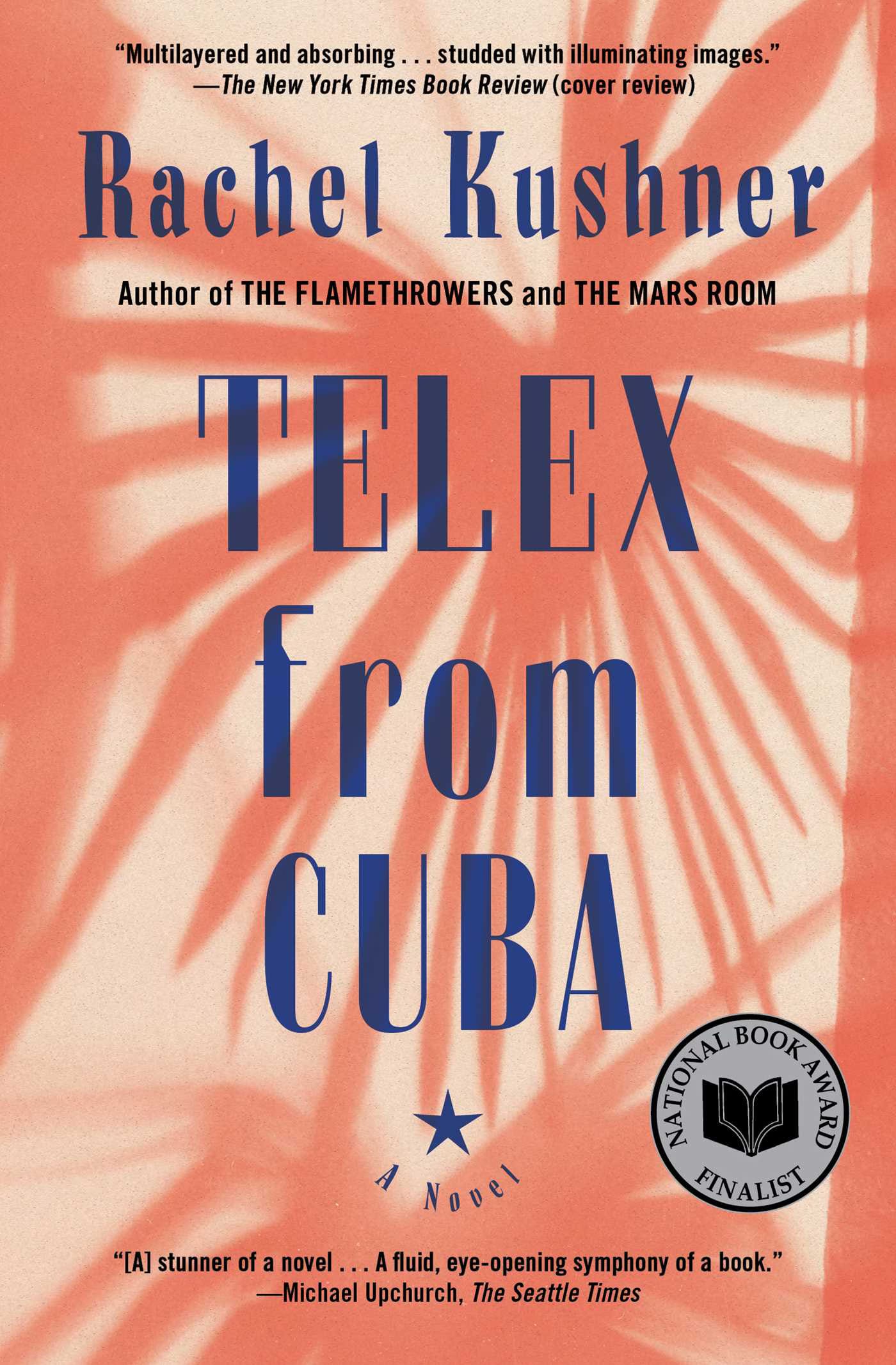Good morning!
I read two historical fiction books this past week with a Cold War theme—Rachel Kushner’s Telex from Cuba (set in 1950s Cuba) and Deborah Levy’s The Man Who Saw Everything (set in 1980s East Berlin). Let’s get into it.
What I read:
Telex from Cuba by Rachel Kushner
Telex from Cuba is Rachel Kushner’s first novel (published in 2008). It takes place in Cuba’s Oriente province and Havana during the 1950s. The book is primarily told through the perspective of the children of the American executives of the United Fruit Company and nickel mines. However, Kushner also follows an array of adult characters.
If there is a main character, it is KC Stites, the son of a United Fruit Company executive (the company had 3,000 acres of sugar cane in Cuba). KC’s chapters are written from the first perspective (he is an adult recounting his childhood). Kushner uses an omniscient narrator for the other characters.
In the Oriente province, we are immersed in the luxurious but shallow world of the American expats. They lounge on golf courses and swimming pools in gated communities while Cuban workers labor in the brutal conditions of the mines and sugar mills. As the novel progresses, we learn that nearly all of the adult characters maintain extramarital affairs. These Oriente chapters read like a historical version of The White Lotus. Meanwhile, Castro’s rebels are fighting in the hills, burning sugar cane fields, and consolidating power.
In Havana, Kushner follows Christian de La Mazière, a French arms dealer who colluded with the Nazis, and a Cuban exotic dancer named Rachel K.
This book is clearly well-researched. Kushner includes thousands of tiny cultural notes and observations, and I felt completely immersed in this world. One Goodreads reviewer aptly describes it as “Mad Men, but set in Cuba and told from the perspective of Sally and Bobby.”
However, this book feels crowded with all of the storylines. The Oriente chapters focus on middle-class ennui and drag on a bit, while the Christian de La Mazière-Rachel K. chapters read like a thriller. These Havana chapters were my favorite parts of the book, but they seemed to be from a completely different book. Kushner also weaves in cameos from real-life people, like the Castro brothers and Hemingway, which I felt mixed on.
Overall, this book impressed me, but I wouldn’t strongly recommend it.
Rating: 3.6/5
Genre: Historical Fiction
Notable prizes/book clubs/lists: National Book Award for Fiction Finalist (2008)
Page count: 322 pages
Audio: 12 hours 55 minutes
The Man Who Saw Everything by Deborah Levy
The Man Who Saw Everything is a literary puzzle of a novel that follows Saul Adler, a twenty-eight-year-old British historian, who travels to Communist East Berlin in September 1988 for academic research. It is divided into two parts.
Part 1: The novel opens in London at Abbey Road with Saul waiting for his girlfriend, Jennifer Moreau. Moreau is a photography student and plans to recreate the famous 1969 Beatles Abbey Road album with Saul standing in the middle of the crosswalk. Shortly before the shoot, a car hits Saul, and he suffers from some superficial injuries. Moreau takes the photos and then breaks up with him later that afternoon.
Three days later, Saul heads to East Berlin. In addition to the research trip, he plans to bury a portion of his father’s ashes in the GDR (his father was an ardent socialist). Although Saul speaks fluent German, the GDR government gives him a translator, Walter Müller. Saul stays with Walter and Walter’s sister, Luna, who works as a nurse and is a bit manic. I won’t spoil the plot of part 1, but Saul quickly emerges as an unreliable narrator (he tells his East German companions that the wall will fall in November 1989).
Part 2: The second part of the book is set in 2016. It opens with another car accident on Abbey Road. This time, fifty-six-year-old Saul suffers life-threatening injuries and is hospitalized. Under the steady drip of morphine and battling sepsis, he struggles to recall his past. He slowly parses through his memories and pieces together what has happened in the past several decades.
My take: I’ve read two of Levy’s other books, Swimming Home and Hot Milk, and like in those novels, Levy packs an astonishing amount into less than 200 pages. Through intricate symbolism, she grapples with the weight of history, memory, knowledge, personal culpability, and political history.
Small details are repeated throughout the novel. For instance, Levy repeats the symbol of a jaguar. Luna fears jaguars; when Saul buries his father’s ashes, he feels like he has “been disemboweled by a jaguar”; and in the second car accident, he is hit by a Jaguar car. Levy also plays with the concept of the “specter” throughout the novel. Saul recalls the famous quote from The Communist Manifesto by Marx and Engels—“a specter is haunting Europe.” Saul uses this term to describe a small wooden train in Walter’s home (it is “like a specter” that torments Saul) and Walter’s unexpected authoritarian tone of voice. When Saul attends a photography exhibition of Jennifer’s work where he is the primary subject, he notes, “There is a specter inside every photograph.” Saul is haunted by the “specters” of his past and the emotional and psychological walls he creates.
Levy also explores East German history through Saul’s memories. There are evident parallels between the surveillance GDR state and elements of Saul’s life. Saul has an authoritarian father and has to censor himself for much of his life by repressing his attraction to men. He is also literally surveilled while in the GDR (he can hear GDR operatives clicking in to listen to his phone calls) and is surveilled in a way by being the subject of Jennifer’s photographs. He feels connected to his East German companions, who seem to “see” him, but do they really understand him, or are they just observing him to inform the Stasi?
The Man Who Saw Everything is like a literary cat’s cradle. It’s destabilizing and often confusing, but gradually, Levy ties together the inconsistencies and little details. The result is astonishing. This book is not for everyone, but I’d recommend this book to readers who love historical literary fiction.
Rating: 4/5
Genre: Historical Fiction; Literary Fiction
Notable prizes/book clubs/lists: Longlisted for the Booker Prize (2019)
Page count: 199 pages
Audio: 6 hours 5 minutes
Movie/TV pairings: The Lives of Others; Goodbye, Lenin!
Food pairings: Canned pineapple
What I generally can’t stop thinking about:
“Inside Prince Harry and Meghan Markle’s Big Business Ambitions, 5 Years After Their Royal Exit” in Vanity Fair
Netflix’s Harry & Meghan in 2022 was the ultimate schadenfreude. This Vanity Fair cover story covers what Harry and Meghan have been up to in the five years since they left the royal family. The magazine spoke with “dozens of people” who have worked with the couple. There are some wild stories of their failed and abandoned projects, like how Harry wanted to host a podcast “where he interviewed powerful men with complicated stories, like Mark Zuckerberg, Vladimir Putin, and Donald Trump.” The concept was about how they became sociopaths:
The person who worked closely with the couple on audio projects recalls Harry saying, “I have very bad childhood trauma. Obviously. My mother was essentially murdered. What is it about me that didn’t make me one of these bad guys?” To implore a season’s worth of world-famous sociopaths to talk about how they developed sociopathy would be what is referred to in access journalism as “a booking challenge.”
“The Enigmatic Artistry of Terrence Malick” in The New Yorker
I loved this review of John Bleasdale’s “The Magic Hours”: The Films and Hidden Life of Terrence Malick, a biography on Malick. Malick’s life experiences in his 20s are absurd:
“I knew one day I’d have to watch powerful men burn the world down—I just didn’t expect them to be such losers” in The Guardian
Regardless of your opinion on the state of the world or the genius of certain tech founders, I think it’s hard to argue that the titans of our tech industry (Zuckerberg, Musk, etc.) are sort of cringe.
“SpaceX loses spacecraft after successful booster catch in Starship test” in The Washington Post
On Friday, a SpaceX starship exploded in a flight test over the Atlantic Ocean. The images are sort of hauntingly beautiful, but the explosion littered debris over the Turks and Caicos Islands.
What I cooked:
A go-to meal salad: Nancy’s chopped salad.
Steak fajitas with Gabriela Cámara’s salsa verde cruda and salsa brava.











